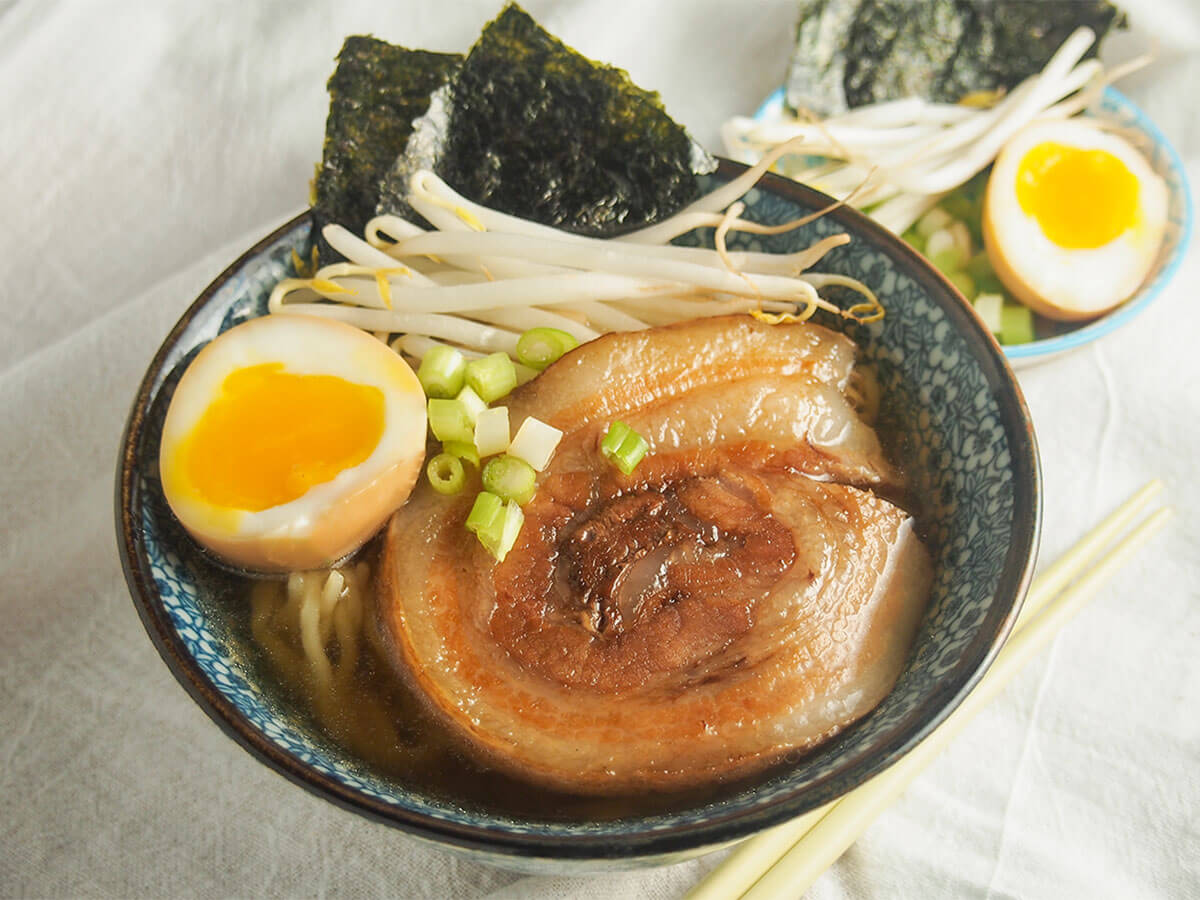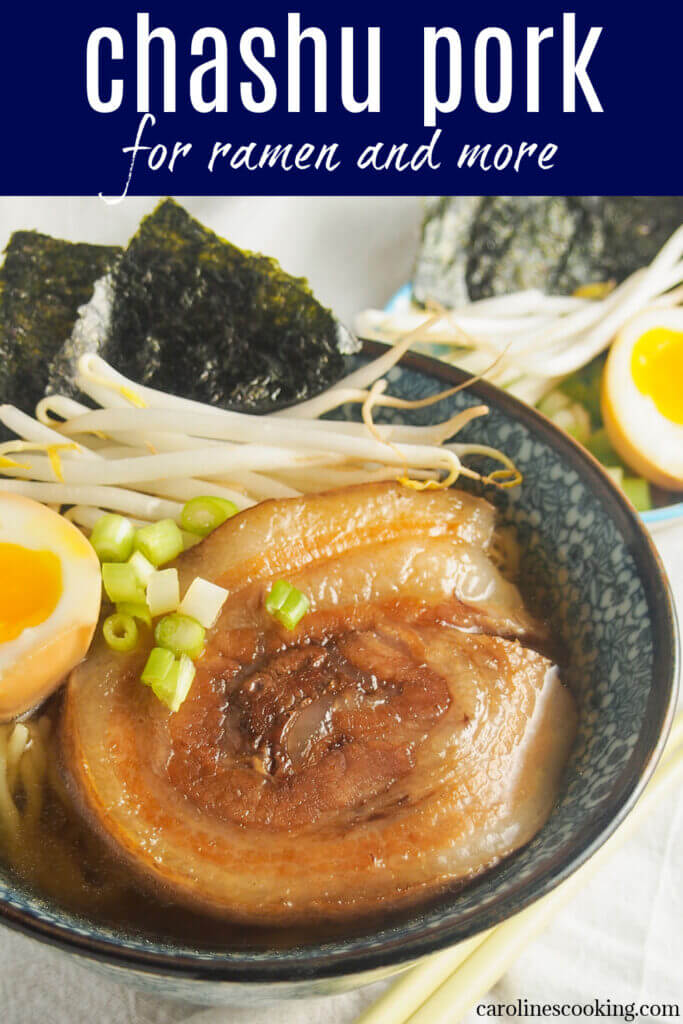Chashu pork is that wonderfully tender and flavorful pork belly you might see on tonkotsu ramen, and other ramen bowls, that's so easy to love. But don't think it's something to only enjoy when eating out - it's actually really easy to make at home and tastes amazing.

This post may contain affiliate links, where we earn from qualifying purchases. See more details in the policy page.
On colder days, a big bowl of ramen can be just the thing to warm you up and get comfortably full on. And I'm not talking about a quick pack of instant noodles (though they can be good too, just not AS good), but an upgraded, loaded-up version.
Switching out a few components, like making your own broth, using good noodles and adding some fresh toppings can make all the difference. And that doesn't mean eating out (or take out) is the only option, nor does it have to be tricky. You can make delicious homemade ramen at home, and this pork is a great addition to any bowl.

Origins of chashu
Chashu is a Japanese dish where pork is slow braised in a relatively simple mixture that includes soy sauce, sugar, mirin and sake and sometimes some aromatics.
Just like the noodles it is served with, chashu originates from Chinese cuisine. The name and broad style of the dish is based on the Cantonese barbecue pork dish, char sui. But the dishes have their differences, too.
Differences between chashu and char sui
While both chashu and char sui are made with pork and have some similarities in having a sweet-savory flavor profile, they also have a few differences.
One big difference is the cooking method. The name "char sui" means fork roasted as that's how it was traditionally cooked, threaded on forks (large, skewer-like ones) over the fire or in an oven. Even more modern versions still either roast or barbecue the meat after marinating it. The marinade gives a sticky, flavorful coating as it cooks.
Chashu, meanwhile, is slow braised in a cooking liquid that contains all the seasonings. These flavors then get into the meat to give it flavor, as well as tenderizing the meat as it cooks. The result is meltingly tender, juicy pork.

The flavors are also a little different. Both incorporate soy sauce and a sweetener, but char sui adds aromatic Chinese five spice, and often hoisin sauce. You traditionally add red yeast rice, though these days that can be replaced with food coloring for a characteristic red color.
For chashu, meanwhile, you simply add mirin and/or sake along with the soy and sugar. If you add aromatics, these are typically ginger and green onion.
Both dishes use boneless pork cuts, most typically pork belly for chashu, though you can use shoulder. Char sui can use a range of cuts including loin, shoulder and neck. It just depends if you want leaner or fattier and juicier.

Steps to make chashu pork (and why)
As you can probably tell from the above, the key to making chashu is time. This isn't a quick dish to make, but you need minimal effort, and only a few ingredients. And another bonus, you largely prepare it ahead so there's minimal work when you are ready to eat and enjoy.
The trickiest bit is rolling and tying the pork belly, though you can potentially skip this. If you just have a small piece of pork, it can work without rolling.
However, rolling helps lock more moisture in the pork and it means slices are an even shape. Plus, it's not actually that difficult. You don't even need to have a huge chunk - as in this recipe, even a smaller piece works to roll.

After that, you first sear the pork which serves a few purposes. It helps add another layer of flavor, helps the pork hold it's shape better, and brings out some of the excess fat before braising.
Then, you slowly braise the pork over a low heat. Cooking low and slow helps the pork to become wonderfully tender. The braising liquid is packed with flavor that works its way into the meat as it cooks, as well as keeping it juicy.
Make sure you turn the pork during braising so that each side spends part of the time in the liquid. This helps it cook evenly.

The next step is one that's key to chashu, that you may not do with some other pork belly recipes - you let it cool then rest the pork in the braising liquid overnight in the fridge. Putting the pork in a freezer bag helps all sides have contact with the liquid.
This step serves two purposes. First, the chilled pork is firmer and easier to slice, but secondly, it gives the meat an extra chance to absorb flavor. In addition, any excess fat from cooking solidifies and floats on top so is nice and easy to discard.

Storing tips
After the initial braising, you can store the pork in the fridge for a couple of days before then slicing and using for ramen or other dishes. After you have left it in the fridge at least overnight, you can also split it up and freeze some for another time.
To freeze, you can cut slices first, or leave it as a chunk, ready to slice after defrosting. Personally I prefer it as a chunk as I find it is less likely to break up that way. Either way, you want to freeze it with some of the braising liquid. You can simply add some to a freezer bag with the pork, and squeeze out excess air.
To use, defrost the pork overnight in the fridge - I recommend sitting the freezer bag in a container, just in case it leaks. Then slice or chop and use in your dish as usual.

For ramen, you typically fry slices of the pork, adding in a little of the braising liquid for extra flavor. This also helps it to caramelize a little on the outside. The other options to cook the slices is to grill or use a blowtorch to warm and caramelize it. You can use slices like this to top a rice bowl too, for example.
Alternatively, you can chop the pork into smaller pieces to make chashu chahan, Japanese fried rice, where you stir fry chunks of pork to crisp it a little (so tasty and easy!).
Top tip: don't throw away the braising liquid
Sure, you skim the fat off, but the main liquid is packed with flavor. You can use some to make ramen eggs (you simply add peeled, soft boiled eggs to some of the liquid overnight). It's also great to add into your ramen broth base for extra flavor.

Chashu pork might take a little time, but it's really an easy dish to make and so worth the effort. The end result is meltingly tender, flavorful pork belly that's a classic ramen topping for good reason.
Try these other tasty pork recipes:
- Maiale al latte (milk braised pork)
- Schweinebraten (German roast pork, using beer to semi-braise)
- Hong shao rou (Chinese sticky braised pork belly)
- Plus get more Japanese recipes in the archives.
Chashu pork (for ramen and more)
Ingredients
- 2 lb pork belly or a little more/less
- 2 green onions spring onions, or 3 if small
- 1 in fresh ginger (a chunk that will give around 4 - 6 slices)
- 2 cloves garlic
- ⅔ cup sake
- ⅔ cup soy sauce
- ¼ cup mirin
- ½ cup sugar
- 2 cups water or a little more as needed
Instructions
- Have some string/kitchen twine ready and a pair of scissors before you prepare the pork. If needed, trim excess fat from the outside of the pork but you still want a later over the meat itself. Roll the piece of pork belly with the fatter end in the middle, and the flatter part making the roll around it. It may be a little tricky to hold together, but try your best as you tie it. Loop a piece of string around one end of the rolled pork and tie it in a double knot so that it holds the pork together. Then, taker the long end of the string and make additional loops around the pork, around ⅔in/2cm apart (or closer), looping through as you go and tightening to make a row of loops, linked together, along the roll. Then loop through over both ends so that it holds the ends in a little better as well and tie off and cut the string. (See pictures and video if you need a bit more guidance on how.)
- Cut the piece of ginger into slices - there's no need to peel it. Peel and trim the ends from the garlic. Trim both ends off the green/spring onions and cut into long lengths.
- Warm a skillet/frying pan large enough to hold the pork but not much bigger, ideally cast iron or at least heavy based. Then sear the pork on all sides to gently brown and seal the pork and fat, including the ends. Start with a fatty side so that some of the fat releases to help with the searing. Once browned all over, remove from skillet and set aside. You can discard the excess fat that has come out.
- Meanwhile, place the sake, soy sauce, mirin, sugar, water and the prepared ginger, garlic and green onions in a pot. You want a pot that is just a little wider than the piece of rolled pork so that it will be mostly covered by the liquid once added. Place over a medium heat, covered, and bring to a simmer, stirring now and then to ensure sugar dissolves.
- Once the sake-soy mixture is simmering, and you have seared the pork, add the pork into the liquid. The liquid should be at least ⅔ up the pork, if not a little more - you can add a little more water if needed. Cover with the lid and bring back to a simmer then reduce the heat so that it simmers gently. Cook for about two hours, turning roughly every 30 minutes so that each side is submerged half the time. If the liquid gets below halfway, then add a little more water.
- After two hours, the pork will be cooked through and should be fairly tender. Turn off the heat and leave the pork to cool in the cooking liquid at least 10 minutes, but you can leave until room temperature. Once cool, remove the pork and set aside a minute. Strain the cooking liquid into a measuring jug to remove the ginger etc. Let it sit a few minutes so that the fat floats to the top then spoon off the fat and discard.
- Place the pork inside a freezer bag, just a little bigger than the pork itself, and sit it in a dish in case of any spills. Then, pour some of the cooking liquid into the bag so that the pork is submerged. Carefully remove excess air from the bag, seal up and then place in the fridge overnight. Don't skip this step, as it helps the pork firm up, but also tenderize further and take in more flavor.
- The next day, when ready to use, carefully take the pork out of the liquid and remove any fat that has solidified on it (that's not park of the pork belly itself). Cut off the string then cut the pork into relatively thin slices, so that you get coiled pieces of the pork belly.
- To prepare it to top ramen, warm some of the cooking liquid in a skillet and then add the pork, a few slices at a time so that they form a single layer. Simmer a couple minutes, carefully turning as needed, so that the pork warms through and gently caramelizes in the liquid. For chashu fried rice, you will instead want to chop the pork further and then fry, along with the rice.
Video
Notes
Nutrition
See some of my favorite cooking tools and ingredients in the Caroline's Cooking Amazon store.
Remember to pin for later!





Helen
Great information! This really helped me to make it. I had no idea this was so easy 🙂
Caroline's Cooking
I'm so glad it all helped!
Saif
I remember my cousin tried Chashu pork in Japan. He loved it and said it was delicious. I will recommend him this recipe. Thank you
Caroline's Cooking
Hope he enjoys!